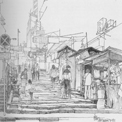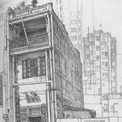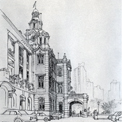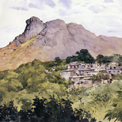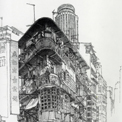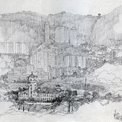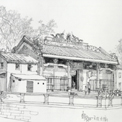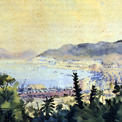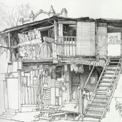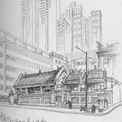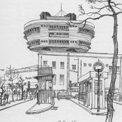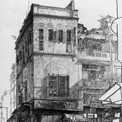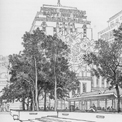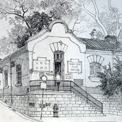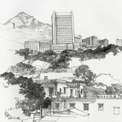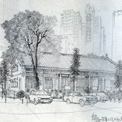Tin Hau Temple, Causeway Bay
Most fishermen worshipped Tin Hau (the Goddess of Heaven), therefore many Tin Hau temples still remain in Hong Kong, and most of these temples are located near the waterfont. The Tin Hau Temple in Causeway Bay was built near the waterfront by Dai Shi-fan during the reign of Qianlong. One day, Dai picked a red censer at that place and believed that this was an indication from heaven that this censer had to be served in the temple. This was formerly called the Red Censer Temple. The Tin Hau Festival is celebrated every 23rd day of the third lunar month. Tien Hau was called "Goddess Matsu", originally a native of the Fujian Province in the Tang Dynasty. She was honoured as a goddess by local fishermen because she saved people who were in great danger.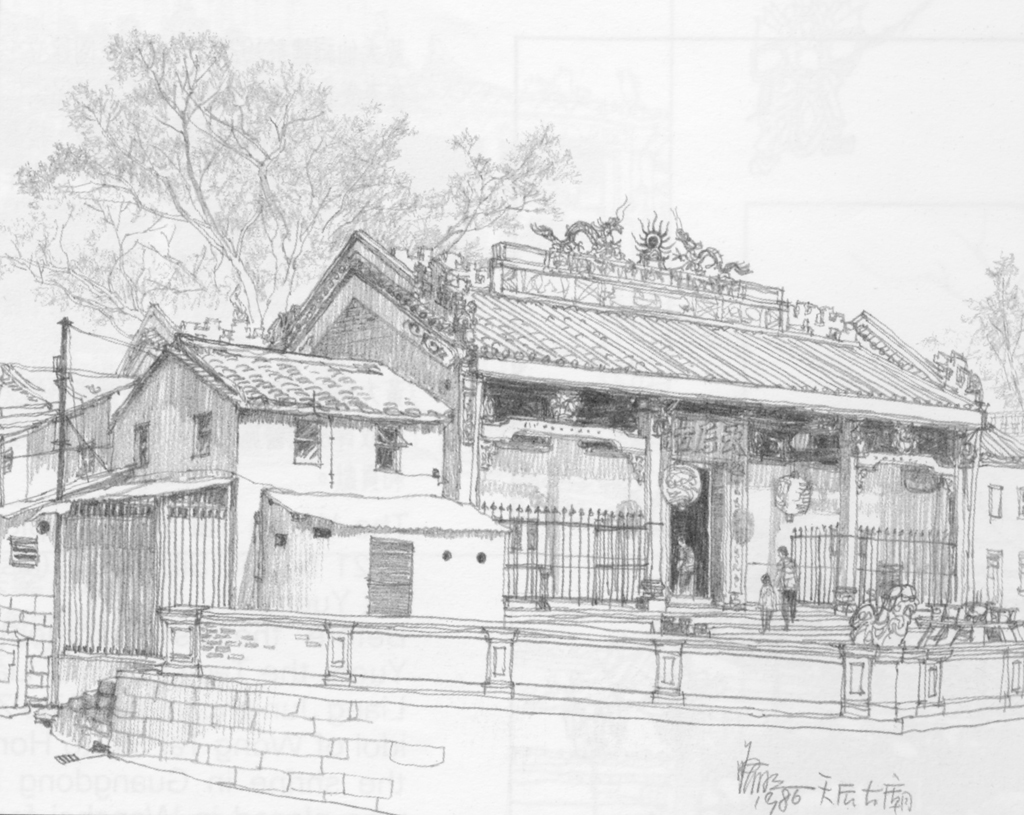
| Date | 1986 |
| Place | Hong Kong Island/Wan Chai District/Causeway Bay/(Street)/Tin Hau Temple |
| people | Kong Kai Ming |
| Material Type | Image |
| Collection | Sketches by Kong Kai-ming |
| Source | Kong, Kai Ming. Landmarks of Hong Kong: Further Artistic Impression. (Hong Kong: The School of Continuing Education, Hong Kong Baptist University, 1994), p.181 |
| Repository | The University of Hong Kong Libraries |
| Note to Copyright | Permission for use is given by Kong Kai Ming |
| Accession No. | LA005-325 |
Tin Hau Temple, Causeway Bay
Most fishermen worshipped Tin Hau (the Goddess of Heaven), therefore many Tin Hau temples still remain in Hong Kong, and most of these temples are located near the waterfont. The Tin Hau Temple in Causeway Bay was built near the waterfront by Dai Shi-fan during the reign of Qianlong. One day, Dai picked a red censer at that place and believed that this was an indication from heaven that this censer had to be served in the temple. This was formerly called the Red Censer Temple. The Tin Hau Festival is celebrated every 23rd day of the third lunar month. Tien Hau was called "Goddess Matsu", originally a native of the Fujian Province in the Tang Dynasty. She was honoured as a goddess by local fishermen because she saved people who were in great danger.
| Date | 1986 |
| Place | Hong Kong Island/Wan Chai District/Causeway Bay/(Street)/Tin Hau Temple |
| People | Kong Kai Ming |
| Material Type | Image |
| Collection | Sketches by Kong Kai-ming |
| Source | Kong, Kai Ming. Landmarks of Hong Kong: Further Artistic Impression. (Hong Kong: The School of Continuing Education, Hong Kong Baptist University, 1994), p.181 |
| Repository | The University of Hong Kong Libraries |
| Note to Copyright | Permission for use is given by Kong Kai Ming |
| Accession No. | LA005-325 |
Tin Hau Temple, Causeway Bay
Most fishermen worshipped Tin Hau (the Goddess of Heaven), therefore many Tin Hau temples still remain in Hong Kong, and most of these temples are located near the waterfont. The Tin Hau Temple in Causeway Bay was built near the waterfront by Dai Shi-fan during the reign of Qianlong. One day, Dai picked a red censer at that place and believed that this was an indication from heaven that this censer had to be served in the temple. This was formerly called the Red Censer Temple. The Tin Hau Festival is celebrated every 23rd day of the third lunar month. Tien Hau was called "Goddess Matsu", originally a native of the Fujian Province in the Tang Dynasty. She was honoured as a goddess by local fishermen because she saved people who were in great danger.
| Date | 1986 |
| Place | Hong Kong Island/Wan Chai District/Causeway Bay/(Street)/Tin Hau Temple |
| People | Kong Kai Ming |
| Material Type | Image |
| Collection | Sketches by Kong Kai-ming |
| Source | Kong, Kai Ming. Landmarks of Hong Kong: Further Artistic Impression. (Hong Kong: The School of Continuing Education, Hong Kong Baptist University, 1994), p.181 |
| Repository | The University of Hong Kong Libraries |
| Note to Copyright | Permission for use is given by Kong Kai Ming |
| Accession No. | LA005-325 |
Tin Hau Temple, Causeway Bay
Most fishermen worshipped Tin Hau (the Goddess of Heaven), therefore many Tin Hau temples still remain in Hong Kong, and most of these temples are located near the waterfont. The Tin Hau Temple in Causeway Bay was built near the waterfront by Dai Shi-fan during the reign of Qianlong. One day, Dai picked a red censer at that place and believed that this was an indication from heaven that this censer had to be served in the temple. This was formerly called the Red Censer Temple. The Tin Hau Festival is celebrated every 23rd day of the third lunar month. Tien Hau was called "Goddess Matsu", originally a native of the Fujian Province in the Tang Dynasty. She was honoured as a goddess by local fishermen because she saved people who were in great danger.
| Date | 1986 |
| Place | Hong Kong Island/Wan Chai District/Causeway Bay/(Street)/Tin Hau Temple |
| People | Kong Kai Ming |
| Material Type | Image |
| Collection | Sketches by Kong Kai-ming |
| Source | Kong, Kai Ming. Landmarks of Hong Kong: Further Artistic Impression. (Hong Kong: The School of Continuing Education, Hong Kong Baptist University, 1994), p.181 |
| Repository | The University of Hong Kong Libraries |
| Note to Copyright | Permission for use is given by Kong Kai Ming |
| Accession No. | LA005-325 |
Tin Hau Temple, Causeway Bay
Most fishermen worshipped Tin Hau (the Goddess of Heaven), therefore many Tin Hau temples still remain in Hong Kong, and most of these temples are located near the waterfont. The Tin Hau Temple in Causeway Bay was built near the waterfront by Dai Shi-fan during the reign of Qianlong. One day, Dai picked a red censer at that place and believed that this was an indication from heaven that this censer had to be served in the temple. This was formerly called the Red Censer Temple. The Tin Hau Festival is celebrated every 23rd day of the third lunar month. Tien Hau was called "Goddess Matsu", originally a native of the Fujian Province in the Tang Dynasty. She was honoured as a goddess by local fishermen because she saved people who were in great danger.
| Date | 1986 |
| People | Kong Kai Ming |
| Material Type | Image |
| Collection | Sketches by Kong Kai-ming |
| Source | Kong, Kai Ming. Landmarks of Hong Kong: Further Artistic Impression. (Hong Kong: The School of Continuing Education, Hong Kong Baptist University, 1994), p.181 |
| Repository | The University of Hong Kong Libraries |
| Note to Copyright | Permission for use is given by Kong Kai Ming |
| Accession No. | LA005-325 |
Tin Hau Temple, Causeway Bay
Most fishermen worshipped Tin Hau (the Goddess of Heaven), therefore many Tin Hau temples still remain in Hong Kong, and most of these temples are located near the waterfont. The Tin Hau Temple in Causeway Bay was built near the waterfront by Dai Shi-fan during the reign of Qianlong. One day, Dai picked a red censer at that place and believed that this was an indication from heaven that this censer had to be served in the temple. This was formerly called the Red Censer Temple. The Tin Hau Festival is celebrated every 23rd day of the third lunar month. Tien Hau was called "Goddess Matsu", originally a native of the Fujian Province in the Tang Dynasty. She was honoured as a goddess by local fishermen because she saved people who were in great danger.
| Date | 1986 |
| Place | Hong Kong Island/Wan Chai District/Causeway Bay/(Street)/Tin Hau Temple |
| People | Kong Kai Ming |
| Material Type | Image |
| Collection | Sketches by Kong Kai-ming |
| Source | Kong, Kai Ming. Landmarks of Hong Kong: Further Artistic Impression. (Hong Kong: The School of Continuing Education, Hong Kong Baptist University, 1994), p.181 |
| Repository | The University of Hong Kong Libraries |
| Note to Copyright | Permission for use is given by Kong Kai Ming |
| Accession No. | LA005-325 |
Tin Hau Temple, Causeway Bay
Most fishermen worshipped Tin Hau (the Goddess of Heaven), therefore many Tin Hau temples still remain in Hong Kong, and most of these temples are located near the waterfont. The Tin Hau Temple in Causeway Bay was built near the waterfront by Dai Shi-fan during the reign of Qianlong. One day, Dai picked a red censer at that place and believed that this was an indication from heaven that this censer had to be served in the temple. This was formerly called the Red Censer Temple. The Tin Hau Festival is celebrated every 23rd day of the third lunar month. Tien Hau was called "Goddess Matsu", originally a native of the Fujian Province in the Tang Dynasty. She was honoured as a goddess by local fishermen because she saved people who were in great danger.
| Date | 1986 |
| Place | Hong Kong Island/Wan Chai District/Causeway Bay/(Street)/Tin Hau Temple |
| People | Kong Kai Ming |
| Material Type | Image |
| Collection | Sketches by Kong Kai-ming |
| Source | Kong, Kai Ming. Landmarks of Hong Kong: Further Artistic Impression. (Hong Kong: The School of Continuing Education, Hong Kong Baptist University, 1994), p.181 |
| Repository | The University of Hong Kong Libraries |
| Note to Copyright | Permission for use is given by Kong Kai Ming |
| Accession No. | LA005-325 |
Tin Hau Temple, Causeway Bay
Most fishermen worshipped Tin Hau (the Goddess of Heaven), therefore many Tin Hau temples still remain in Hong Kong, and most of these temples are located near the waterfont. The Tin Hau Temple in Causeway Bay was built near the waterfront by Dai Shi-fan during the reign of Qianlong. One day, Dai picked a red censer at that place and believed that this was an indication from heaven that this censer had to be served in the temple. This was formerly called the Red Censer Temple. The Tin Hau Festival is celebrated every 23rd day of the third lunar month. Tien Hau was called "Goddess Matsu", originally a native of the Fujian Province in the Tang Dynasty. She was honoured as a goddess by local fishermen because she saved people who were in great danger.
| Date of Death | 1986 |
| Place | Hong Kong Island/Wan Chai District/Causeway Bay/(Street)/Tin Hau Temple |
| People | Kong Kai Ming |
| Material Type | Image |
| Collection | Sketches by Kong Kai-ming |
| Source | Kong, Kai Ming. Landmarks of Hong Kong: Further Artistic Impression. (Hong Kong: The School of Continuing Education, Hong Kong Baptist University, 1994), p.181 |
| Repository | The University of Hong Kong Libraries |
| Note to Copyright | Permission for use is given by Kong Kai Ming |
| Accession No. | LA005-325 |
Tin Hau Temple, Causeway Bay
Most fishermen worshipped Tin Hau (the Goddess of Heaven), therefore many Tin Hau temples still remain in Hong Kong, and most of these temples are located near the waterfont. The Tin Hau Temple in Causeway Bay was built near the waterfront by Dai Shi-fan during the reign of Qianlong. One day, Dai picked a red censer at that place and believed that this was an indication from heaven that this censer had to be served in the temple. This was formerly called the Red Censer Temple. The Tin Hau Festival is celebrated every 23rd day of the third lunar month. Tien Hau was called "Goddess Matsu", originally a native of the Fujian Province in the Tang Dynasty. She was honoured as a goddess by local fishermen because she saved people who were in great danger.
| Date | 1986 |
| Material Type | Image |
| Collection | Sketches by Kong Kai-ming |
| Source | Kong, Kai Ming. Landmarks of Hong Kong: Further Artistic Impression. (Hong Kong: The School of Continuing Education, Hong Kong Baptist University, 1994), p.181 |
| Note to Copyright | Permission for use is given by Kong Kai Ming |
| Accession No. | LA005-325 |
Tin Hau Temple, Causeway Bay
Most fishermen worshipped Tin Hau (the Goddess of Heaven), therefore many Tin Hau temples still remain in Hong Kong, and most of these temples are located near the waterfont. The Tin Hau Temple in Causeway Bay was built near the waterfront by Dai Shi-fan during the reign of Qianlong. One day, Dai picked a red censer at that place and believed that this was an indication from heaven that this censer had to be served in the temple. This was formerly called the Red Censer Temple. The Tin Hau Festival is celebrated every 23rd day of the third lunar month. Tien Hau was called "Goddess Matsu", originally a native of the Fujian Province in the Tang Dynasty. She was honoured as a goddess by local fishermen because she saved people who were in great danger.
| Date | 1986 |
| Material Type | Image |
| Place | Hong Kong Island/Wan Chai District/Causeway Bay/(Street)/Tin Hau Temple |
| People | Kong Kai Ming |
| Collection | Sketches by Kong Kai-ming |
| Source | Kong, Kai Ming. Landmarks of Hong Kong: Further Artistic Impression. (Hong Kong: The School of Continuing Education, Hong Kong Baptist University, 1994), p.181 |
| Repository | The University of Hong Kong Libraries |
| Note to Copyright | Permission for use is given by Kong Kai Ming |
| Accession No. | LA005-325 |
Tin Hau Temple, Causeway Bay
Most fishermen worshipped Tin Hau (the Goddess of Heaven), therefore many Tin Hau temples still remain in Hong Kong, and most of these temples are located near the waterfont. The Tin Hau Temple in Causeway Bay was built near the waterfront by Dai Shi-fan during the reign of Qianlong. One day, Dai picked a red censer at that place and believed that this was an indication from heaven that this censer had to be served in the temple. This was formerly called the Red Censer Temple. The Tin Hau Festival is celebrated every 23rd day of the third lunar month. Tien Hau was called "Goddess Matsu", originally a native of the Fujian Province in the Tang Dynasty. She was honoured as a goddess by local fishermen because she saved people who were in great danger.
| Date | 1986 |
| Place | Hong Kong Island/Wan Chai District/Causeway Bay/(Street)/Tin Hau Temple |
| People | Kong Kai Ming |
| Material Type | Image |
| Collection | Sketches by Kong Kai-ming |
| Source | Kong, Kai Ming. Landmarks of Hong Kong: Further Artistic Impression. (Hong Kong: The School of Continuing Education, Hong Kong Baptist University, 1994), p.181 |
| Repository | The University of Hong Kong Libraries |
| Note to Copyright | Permission for use is given by Kong Kai Ming |
| Accession No. | LA005-325 |
Tin Hau Temple, Causeway Bay
Most fishermen worshipped Tin Hau (the Goddess of Heaven), therefore many Tin Hau temples still remain in Hong Kong, and most of these temples are located near the waterfont. The Tin Hau Temple in Causeway Bay was built near the waterfront by Dai Shi-fan during the reign of Qianlong. One day, Dai picked a red censer at that place and believed that this was an indication from heaven that this censer had to be served in the temple. This was formerly called the Red Censer Temple. The Tin Hau Festival is celebrated every 23rd day of the third lunar month. Tien Hau was called "Goddess Matsu", originally a native of the Fujian Province in the Tang Dynasty. She was honoured as a goddess by local fishermen because she saved people who were in great danger.
| Date | 1986 |
| Place | Hong Kong Island/Wan Chai District/Causeway Bay/(Street)/Tin Hau Temple |
| People | Kong Kai Ming |
| Material Type | Image |
| Collection | Sketches by Kong Kai-ming |
| Source | Kong, Kai Ming. Landmarks of Hong Kong: Further Artistic Impression. (Hong Kong: The School of Continuing Education, Hong Kong Baptist University, 1994), p.181 |
| Repository | The University of Hong Kong Libraries |
| Note to Copyright | Permission for use is given by Kong Kai Ming |
| Accession No. | LA005-325 |
Tin Hau Temple, Causeway Bay
Most fishermen worshipped Tin Hau (the Goddess of Heaven), therefore many Tin Hau temples still remain in Hong Kong, and most of these temples are located near the waterfont. The Tin Hau Temple in Causeway Bay was built near the waterfront by Dai Shi-fan during the reign of Qianlong. One day, Dai picked a red censer at that place and believed that this was an indication from heaven that this censer had to be served in the temple. This was formerly called the Red Censer Temple. The Tin Hau Festival is celebrated every 23rd day of the third lunar month. Tien Hau was called "Goddess Matsu", originally a native of the Fujian Province in the Tang Dynasty. She was honoured as a goddess by local fishermen because she saved people who were in great danger.
| Date | 1986 |
| Place | Hong Kong Island/Wan Chai District/Causeway Bay/(Street)/Tin Hau Temple |
| People | Kong Kai Ming |
| Material Type | Image |
| Collection | Sketches by Kong Kai-ming |
| Source | Kong, Kai Ming. Landmarks of Hong Kong: Further Artistic Impression. (Hong Kong: The School of Continuing Education, Hong Kong Baptist University, 1994), p.181 |
| Repository | The University of Hong Kong Libraries |
| Note to Copyright | Permission for use is given by Kong Kai Ming |
| Accession No. | LA005-325 |
Copyright © 2012 Hong Kong Memory



